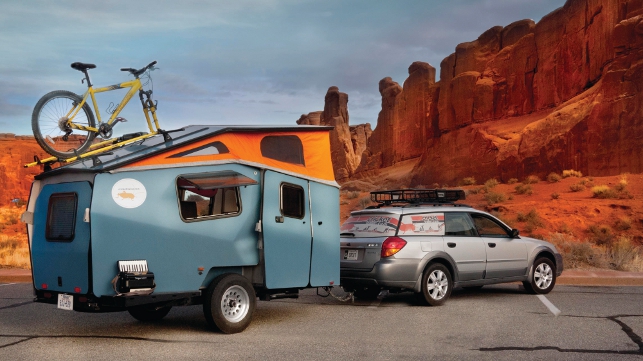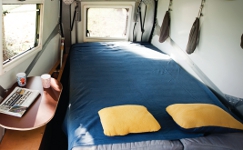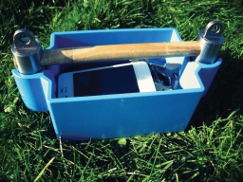What happens when a NASA space architect with a love of the great outdoors turns his hand to designing a caravan? The Cricket Trailer is born.

The spring loaded pop-top produces the Cricket Trailer’s spacious interior in about twenty seconds
Designed, developed and produced out of a small factory in Houston, Texas, this rugged and space efficient outdoor living space is aimed at individuals, couples or small families. “It’s a lightweight, athletic camping machine for you to have adventures in,” says the Cricket Trailer’s inventor Garrett Finney.
Having qualified as an architect, in 1999 Finney moved to Houston to work as a habitation module designer for NASA. He created the environments, including the crew porters and kitchens, that the astronauts would eat, sleep and relax in onboard the International Space Station.
“The challenge was not only creating a machine that can support life but one whose environment can support life in a way that is relatively normal, comfortable and easy,” he explains.
Back to earth
Although the work was enjoyable, when Finney discovered after four years that the module he cared most about would never actually take off (quite literally), he decided to leave.
With his love of camping, he initially wanted to get a job redesigning State Park campgrounds, which hadn’t changed much since the 1940s and 1950s although now had to cope with massive caravans or recreational vehicles (RV), as they are known in the US.
“I wanted to write the rules that National State Campgrounds should establish to force the caravan industry to become what it ought to be,” says Finney.
Although he didn’t quite manage to do that, he decided to do the next best thing which was to actually design a camping trailer that would provide a better alternative to these ‘bigger is better’ caravans.
“RVs are often the biggest things people can afford rather than something that is light on the land, sustainable and easily towed by many different types of vehicle,” comments Finney.
“I thought that a lot of people would rather have something small, efficient, sustainable and comfortable with the whole point being that they want to be in the great outdoors having an adventure rather than bringing their house with them with all its amenities,” he adds.
Idea comes to life
So, he got to work sketching his ideas. His plan was to make it as narrow as a car and long enough so that it would fit inside a garage (4.6 x 2 metres), any smaller and it would mean that the trailer would have to be set up more when it arrived at its destination. He also wanted it to be tall enough so that users could sit comfortably inside without having to pop the roof up.
Finney’s preliminary sketches featured a mechanism to raise and lower the roof that looked a lot like the jumping leg of a cricket. “The working title became Cricket and we decided to stick with that even though the cricket leg started to disappear from the design,” he explains. “We liked the name cricket because they are happy insects that people associate with camping all over the world.”
Then, following the design process used at NASA, he quickly moved on to making a few small models before mocking up a full-scale, cardboard model in an empty shop front next to his office. “We put the coffee machine in there so everyone had to go in and out bumping into one another.
We also had small meetings around the table and although I don’t quite authorise naps during work, we’d lie down and pretend to sleep and then get up and pretend to cook or take a shower,” describes Finney. “So we tried to prove that space by running people through it instead of just drawing a nice picture.”
Finney took a systems approach to the design, which is the understanding of how things influence one another within a whole, something else he’d learnt during his years at NASA. “At NASA I was designing for small enclosed environments where you can’t make any assumptions.
Even the hair that falls off your head everyday becomes a trash problem in space. It collects in an air filter and you have to figure out how to take care of that over time. Bringing that complete system viewpoint down to earth is where the Cricket was conceived,” he describes.
By using some efficient space saving measures, he wanted to pack a lot into a small package but also allow user’s to customise the interior to how they wanted. As for the exterior, having looked at a variety of materials he decided to fabricate it using folded-aluminium composite panels that would provide insulation without warping, mould or formaldehyde fumes.
All systems go
As part of the systems approach, the trailer was also conceived to be inherently sustainable.
“Our aim is to be systematically and systemically green by considering the product as part of an ecosystem of camping that encapsulates not only the weight and detail of the trailer itself but the car towing it, the cost of gas, how state parks can handle small things better than big things and how camping is about adventure and not about bringing a house on wheels,” he says.
So, once Finney and his team had lived with the fullscale model in the office and considered the size and layout of it, they moved into modelling it in 3D. The design was largely done in Rhino and then these files exported to AutoCAD in order to produce the CAD files.
AutoCAD might seem an unusual chose but it is a tool he is familiar with from his background in architecture and is comfortable using. From these CAD files they produced their first full-scale prototype, which Finney is not ashamed to admit broke.
“Caravans are not subject to the same federal testing programmes that automobiles are, which means that the habitation compartments have to be self-certified by the manufacturers themselves for safety issues such as fire and electric shock,” he explains.
“We are coming at it from the left field and trying to be the non-RV RV or non-caravan caravan. We don’t have 50 years experience of building these things. So, in our first few prototypes we made stupid errors that architects would make. For example, we wired it as if it was a house instead of a vehicle so wires shook themselves apart,” he adds.
Little by little
But it’s all part of the learning curve of a new company attempting to develop an innovative new product.
Sourcing and manufacturing is also a part of this and having relocated to a nearby 5,000 square foot factory, the plan was to outsource some components, make some themselves and then assemble it in-house. Currently, the laser cut skeleton of the trailer is outsourced to a nearby company in Houston.
However, Finney recently purchased a CNC router to enable them to cut all their own cabinetry for the interior and the folded-aluminium exterior shell. From a manufacturing perspective, folded panels made the most sense because if any changes needed to be made, the CAD files would merely need to be adjusted and the CNC machine would then cut that new shape.
“The Cricket Trailer is not just a box – we’ve designed a puzzle that we think is not only fun looking and practical but also allows us to develop future models using the same CADCAM attitude,” he says.
“We are not investing in tooling, we are sourcing the use of machines. This means that we are not locked into a particular shape, so we can constantly improve our product but also develop and experiment with new trailers, both smaller and larger than the Cricket, in the future,” adds Finney.
For him, it is really figuring out what works best and trying to find the easiest, least expensive but also most sustainable solution possible. “We are trying to bring a fresh outside attitude to all these typical production problems, which are problems that in ten years time we’ll probably be experts in,” smiles Finney.
Although so far Finney has only produced the trailer for friends and interested strangers, it is only in the last five months that they have got into the factory mode.
Currently the product is produced in small batches of five to seven however, Finney is looking to move to a bigger factory and hopefully double that, especially as their order book is full until October 2012.
“Right now we build the trailers in batches but we are working up to a line production and then delivering in batches,” he explains.
Cricket is going global
Finney is also establishing a sales and distribution channel not just in the US but worldwide. This is proving tricky because potential customers are not just typical RV and caravan owners.
“The crux of the business plan was to find those people who used to sleep on the ground and for whatever reason don’t want to anymore but don’t want a house on wheels either. They want a place to sleep comfortably, to cook, to be out of the weather and to be able to go to the bathroom in the middle of the night.
So whether that’s because they are ‘empty nesters’, a couple that have just had their first child who want some comfort and security or whether it’s a hunter or fisherman who will use it as a mobile base-camp to secure gear. I have lots of ideas about who should be in the cricket,” he says.
This has meant that Finney and his team have taken the Cricket Trailer with them to a variety of events such as surfing contests, various outdoor events and even music festivals. “It has been fun figuring out where our customers are,” says Finney.
“I really can’t wait for more people to start using Cricket. I want to hear about the adventures they are having and places they have been. It’s why I designed it.”
Safe and sound
For most the experience of camping is wonderful, but if you’ve ever fallen victim to theft, the experience can be devastating.
However, product designer and inventor Tom Lawton has designed a device that will keep your valuables safe when you are away from your tent.
His invention Lockdown, is a portable outdoor stash-box with additional fixture points that will keep valuables rooted to the ground. “Of course, if someone really wants to steal your stuff they will find a way – much like any bike or shed lock – Lockdown is about making it difficult so they bugger off,” smiles Lawton.
Lawton had the original idea for Lockdown back in 2007. Glastonbury was about to take place and I was listening to radio DJ Jo Whiley talking to Stuff Magazine editor Tom Dunmore on Radio One.
A listener had phoned in asking for a means of keeping her valuables safe while camping at the festival. Tom was unable to recommend a product that didn’t require being secured to a fixture of some sort.
I went for a walk with my sketchbook in hand, and began to doodle and wonder,” describes Lawton.
He was looking for a no-nonsense, simple and robust solution that would offer a first level of defense against opportunist tent theft.
“I wasn’t interested in making people’s valuables impenetrable to all theft, as I knew that there would be price point sensitivity and whatever I devised would have to be carried (together with booze and tent) in a rucksack, across miles of quagmire,” he comments.
As he was thinking about what this product could be he noticed how a tree’s root system had entwined itself in a wall he was sitting on. I tried to pull it out of the wall and ground – that obviously wasn’t going to happen easily and I thought long and hard about ground anchorage,” he says.
Lawton initially started off by testing a variety of ground screws. Using two screws locked together he discovered that each prevented the other from being unscrewed. This was the essence of his design.
He then mocked up some concept visuals and presented them to Firebox.com, an internet retailer, who loved the idea.
“By first identifying an initial route to market it was then easier to find resource to fund the prototyping, patenting and production of the product, which all followed afterwards,” says Lawton.
“I worked closely with the team at Amalgam Modelmakers in Bristol and we broke quite a lot of screw heads before perfecting the profile and prescribing an injection moulded mix of nylon and fibre glass for my screw tips.”
With production currently underway, Lockdown will be available through Firebox.com late this summer, just in time for a few festivals and late summer camping. 
The Cricket Trailer – an adventure on wheels
Default










